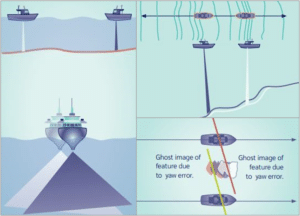Select the right system for your specific needs
For every first-time buyer of a multibeam echosounder, choosing the right survey equipment can be intimidating and confusing. Here is a handy guide to help you select the right multibeam sonar.
1. First, set your priorities
Start defining what matters to you based on the type of areas you will survey the most, i.e. resolution, speed of survey, frequency capabilities, etc.
Regardless of the type of multibeam echosounder you will choose, you will have to make trade-offs (that are governed by laws of physics).
For example, the water depth of the area to survey may determine the operating frequency: in deep waters, the operating frequency will be lower and therefore the beamwidth will be larger, resulting in lower resolution. In contrast, in shallow waters, the operating frequency can be higher, resulting in greater resolution (smaller beamwidth).
2. Have the freedom to choose the optimum operating frequency at any time, without losing any information
Ensure you have the flexibility to select the most appropriate frequency for your specific survey in a given environment and its particular conditions. Factors including salinity, temperature, tide, and external interference can all create noise and therefore impact the preferred operating frequency.
Sometimes, you may have to change the frequency during the survey because there are new interferences that compromise the survey. It’s then critical to not lose any data when you switch frequencies; else you may have to re-survey the area!
3. Keep in mind that the multibeam echosounder alone cannot ensure a successful survey
The multibeam sonar is not the only component in the survey system. Other parts play critical roles and must be selected carefully. As indicated by the International Hydrographic Organization (IHO), “It is also important to note that the adequacy of a survey is the end product of the entire survey system and processes used during its collection.” Further: “All components and their combination (sic) must be capable of providing data to the required standard.” (Ibid.)
Check the mounting system, other sensors (positioning, motion, heading) and the sound velocity profiler, verify the offset measurements and become familiar with the data collection and processing software.
4. See through the specs
Approach technical specs with a clear head, homing in on how they relate to your intended surveys. When comparing spec sheets, some terms sound similar, but may refer to different concepts, and other features can be confusing or misleading, especially if they have unique terms.
For example, a multibeam sonar doesn’t measure depth, it measures range. When you review a manufacturer’s specifications, separate the wheat from the chaff and demand unambiguous answers and real-world examples to pointed questions.
5. Take advantage of training
Verify that you will receive comprehensive, customized and hands-on training with your purchase so you get the most out of your investment.
6. Plan for the unknown and unpredictable. Be sure of 24/7/365 support
Questions, doubts and complex queries can all come up while you’re busy on a survey. It’s imperative to purchase from a manufacturer that offers reliable and immediate 24/7/365 technical support. Be cautious with generic numbers like 800-numbers, and annual pay-for-service agreements.
7. Minimize your risks
Multibeam sonars are a significant investment. By securing a long-term warranty, you minimize risk and maximize your investment over the long run.
8. Be curious, ask questions and rely on reviews and testimonials
Ask all the tough questions you can think of before you make a final decision. Sometimes features that look advantageous at first can lead to problems down the road. Be critical, ask for images, proof, demos and referrals, and talk to current users. Continue asking for additional information until you feel 100% confident in your decision. Reputable companies with quality products will be happy to provide all the information you seek, including a demo. You likely wouldn’t buy a car without test-driving it, so why do it with a multibeam sonar?
9. Keep it simple
Multibeam survey already involves various equipment, measurements and adjustments. Make your life easy by choosing a multibeam echosounder that is easy to both install AND operate – but never at the expense of reliability or performance.
10. This is a big investment. Think long-term
By choosing a multibeam sonar that is easily upgraded with new and different technical modes, you can unlock valuable new opportunities that can help you win new business.




